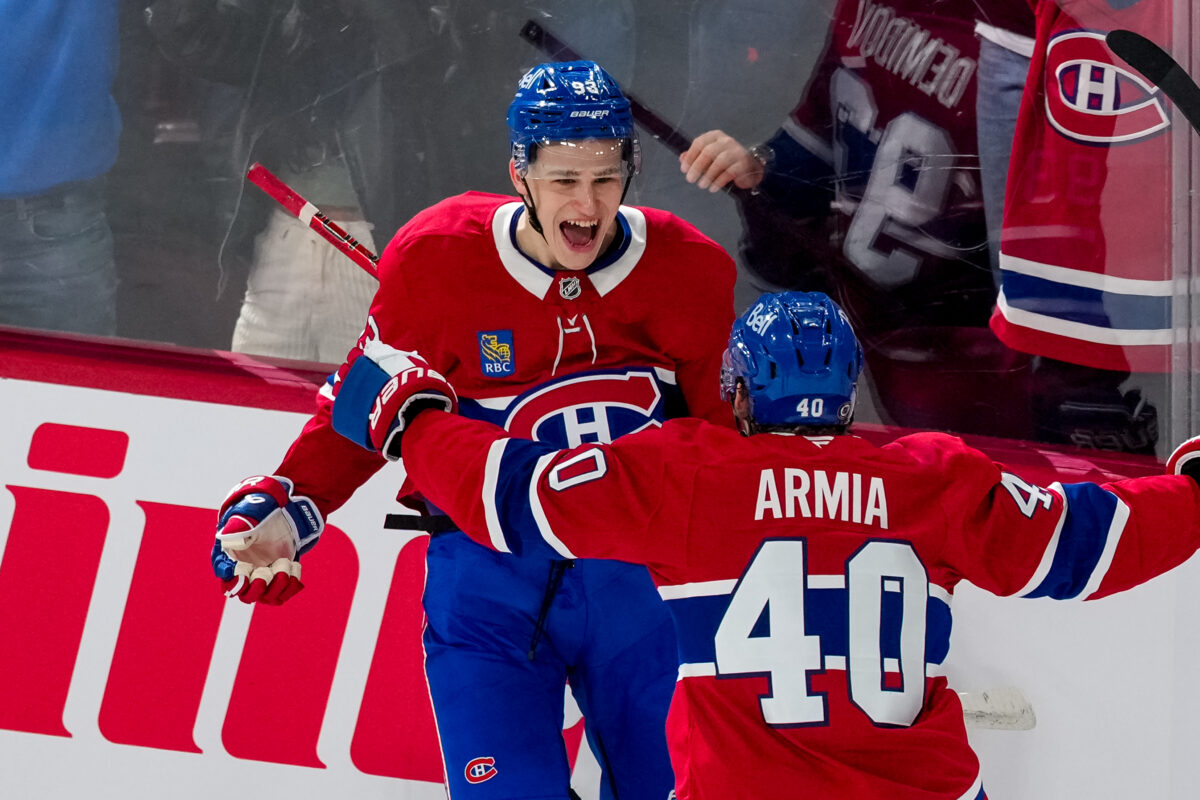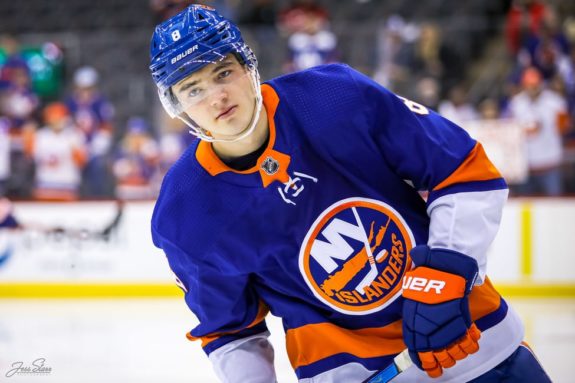In 2025-26, the Montreal Canadiens are hoping to continue a trend they started once they finished last in the NHL four years ago. Each season since, they’ve increased their point totals, which has so far culminated in their first playoff berth since 2021 this past spring. They’re far from satisfied.
Not only do they have momentum on their side. The Canadiens also are significantly better, at least on paper, relative to the team they iced in 2024-25 that got eliminated in five games in Round 1. There’s every reason to believe they can get further, improve on their wild-card finish in the standings or both. Here are the top five ways:
5. More Experience
According to some sources, the Canadiens were the youngest team to make the Stanley Cup Playoffs in history. Based on NHL rosters in mid-July, they are also the youngest team in the league right now, which is significant in the sense their young core is still a year older relative to where each member was to start last season.
Average ages according to NHL media site rosters :
— NHL Rosters (@NHL_Rosters) July 11, 2025
1. Montreal – 25.75
2. Buffalo – 26.51
3. Chicago – 26.62
4. Ottawa – 26.88
5. Philadelphia – 27.32
6. Calgary – 27.63
7. Anaheim – 27.71
8. Columbus – 27.75
9. Boston – 27.87
10. NY Rangers – 27.91
11. New Jersey – 28.00
12.…
That should constitute a dangerous proposition for the rest of the NHL, considering how, starting last Dec. 3, the Canadiens went 32-18-8. That amounts to a .621 points percentage, which would put the Habs on par with the Colorado Avalanche and Tampa Bay Lightning (over their entire seasons), two teams widely considered powerhouses.
4. Full Seasons from Carrier, Dobes and Laine
That Dec. 3 date is significant, because it represented Patrik Laine’s Canadiens debut, after he suffered a serious knee injury in a preseason game. Soon thereafter, the Habs traded for defenseman Alexandre Carrier, who helped stabilize the defense. Soon after that, they promoted goalie Jakub Dobes, who went 7-4-3 with a 2.74 goals-against average and .909 save percentage.
In a way, despite simply being a backup to starter Sam Montembeault, Dobes was the most significant addition of all, as the Habs displayed significantly more trust in him than his predecessor, Cayden Primeau. That allowed them to rest Montembeault more frequently, keeping him fresh to the point he finished in the top five in terms of goals saved above expected (per MoneyPuck.com). From the point at which Dobes debuted on Dec. 28, he started 15 games over a span of the team’s remaining 48. Primeau had started seven (34).
What’s maybe more telling to that effect? Dobes played in 16 total regular-season games, having to appear in only one more game than he started. Primeau appeared in 11, four more than his number of starts. Montembeault was simply more consistent in the second half, making Dobes’ promotion the start of a domino effect (for the better).
3. A Full Season from Demidov
Of all the Canadiens’ additions, Ivan Demidov is by far the biggest as a projected Calder Memorial Trophy favourite. He obviously came over earlier than initially expected to end last season, scoring a goal and an assist in his first period of work (admittedly going scoreless from that point on to close the regular season).

It goes beyond the suggestion Demidov should be an impressive addition compared to other rookies this coming season, though. Nothing is guaranteed obviously, but he is widely considered a game-breaking talent who should slot right into (and provide a significant boost to) the Canadiens’ top six to start his NHL career.
2. More Depth up Front
Demidov’s arrival is a symptom of a larger phenomenon. He shifted Laine to left wing, adding more depth there. When the Canadiens acquired Zachary Bolduc, who scored an impressive 19 goals for the St. Louis Blues as a rookie last season in a bottom-six role (1:18 per game on the power play), they added further to their depth on the wing. The recent signing of Joe Veleno gives head coach Martin St. Louis even more options when constructing his forward group.
The Canadiens may have lost names like Joel Armia and Christian Dvorak to free agency and Emil Heineman via trade. However, despite the team’s tendency to experiment with them in the top six, nothing ever really took. Armia had even been demoted to start 2023-24, while Heineman had only scored a single assist in his last 25 games (in 2025-26). Maybe the car accident he got into as a pedestrian to start the calendar year impacted his effectiveness. It may have, but, all due respect to him, the Habs still upgraded on a player who had grown ineffective down the stretch even so, regardless of the unfortunate circumstances surrounding his downturn.
Dvorak, who had been acquired by ex-general manager Marc Bergevin to become the team’s second-line centre, never really fit in that role. And, while he showed some sustained flashes of being able to contribute offensively, he still scored just 103 points in his four seasons (232 games) with the team, only playing a full season once.
Current-GM Kent Hughes did recently give him the benefit of the doubt in a media availability, suggesting the Dvorak who scored six goals and 13 points in the final 17 games of the season was more representative of the player, now that he was healthy. However, seeing as Hughes had traded for Kirby Dach (and Sean Monahan) in his first offseason to effectively replace Dvorak in the top six and drop him down the lineup, the logical conclusion is Hughes himself didn’t see him as a No. 2 centre either.
There was simply no understandable way the Canadiens could justify re-signing Dvorak, especially when the Philadelphia Flyers gave him $5.4 million for next season. The Habs could have maybe justified keeping him with a cut in salary, based on his down-trending production, having scored 33 points in 56 games in 2021-22 when he first arrived and 33 points in 82 games this past season.
For the sake of argument, look at Veleno as his replacement at centre. It’s not a perfect comparison, because Veleno is more so perceived as a reclamation project who may or may not pan out, while Dvorak is established as a veteran presence down the middle who is significantly better at face-offs. However, the Canadiens just cut ties with a 29-year-old now making $5.4 million who scored nine points in 30 games in 2023-24. They replaced him with a 25-year-old making $900,000, who scored 28 points (80 games) that same season. Sure, their respective 2024-25 campaigns went differently, with Dvorak scoring his 33 points and Veleno notching just 17 in a season split between the Detroit Red Wings and Chicago Blackhawks. However, if Dvorak can rebound from a poor 2023-24 to post average offensive numbers, a player in his prime production years can too. That’s a win.
Related: Canadiens Absorb Zero Risk with Joe Veleno Signing
To be fair, Dach has underwhelmed as the team’s No. 2 centre and is coming off a second consecutive season-ending knee injury. So, not everything Hughes touches turns to gold. However, if the Canadiens managed to improve as much as they did in 2024-25 without a viable second-line centre, it’s safe to say they’ll enjoy more success overall, regardless of who ends up filling the role. It’s easy to see even a healthy, rejuvenated Dach contributing more in the position than he just did, which bodes well for the team’s overall chances.
1. Dobson on Defensive Side of Things
It’s harder to say the Canadiens are deeper on defense. Looking past the option they’ll inevitably take advantage of to play one of their left-handed defensemen on the right, they technically only have prospect David Reinbacher as their third-best player there, implying they may have to rush him to the NHL this coming season.
After all, the Canadiens traded another top defensive prospect in the right-handed Logan Mailloux to acquire Bolduc, which is a step back in that (one) regard. They also replaced a retiring David Savard on the right by trading for Noah Dobson, which is technically a lateral move. However, even though they only have Carrier and Dobson on that right, they are undeniably stronger with the latter now in the fold.
Breaking it down, Dobson is a 25-year-old, in-his-prime defenseman who is just one season removed from having scored a career-high 70 points. Savard was a 34-year-old stay-at-home defenseman who, despite his willingness to sacrifice his body for the betterment of the team, was more likely to suffer through a shift hemmed in, in his own zone than help the team transition to offense. While Dobson receives flak for his defensive play, he’s really only more likely to give the puck away because he has the puck so often, as this list of the league’s top giveaway leaders in 2024-25 generally proves. Coincidentally, Hab Lane Hutson had one more than Dobson (109 vs. 108) and no one should be able to argue with a straight face that the Canadiens shouldn’t want last year’s Calder winner on the team.

In Hutson, you’re talking about an offensive dynamo who made the Canadiens and established himself as a top defenseman in the same organization as Mailloux, despite being one year younger, on a side with significantly more depth. It goes to show, despite having piled up the points and accolades in the American Hockey League, Mailloux simply wasn’t ready from a defensive standpoint, whereas the Habs were more than comfortable trading Heineman and two first-round picks to the New York Islanders to acquire Dobson rather than rush him to the NHL. Ultimately, they went with the proven commodity in Dobson, because they can’t be 100% sure how Mailloux’s AHL success would translate at the game’s highest level. And, after they surprisingly earned a playoff spot in 2025, they can’t afford to rely on an unknown, even in a bottom-pairing, sheltered capacity.
Obviously, if an offensively capable top-pairing defenseman, which Dobson is based on how he led the Islanders in ice time for two straight seasons, becomes available at Age 25, you seize that opportunity. However, the Canadiens first paying the cost they did to acquire him and then agreeing to pay him $9.5 million per year rather than take a chance on a rookie speaks to higher standards. Taking everything into account, the Habs should have little problem meeting them in 2025-26.
